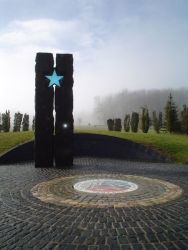Wolfe's Pond Park
The Beach at Wolfe’s Pond Park
This beach was formed nearly 20,000 years ago during the final stages of the last ice age. As the Wisconsin ice sheet advanced southward, it pushed vast amounts of clay, sand, and gravel along in a mass called the terminal moraine. The moraine marks the southern limit of its progress; as the ice melted, the debris was left behind creating beaches such as this one. A narrow band of cobble beach lies between the high and low tide marks, and, with the more inland dunes and clay bluffs, provides a habitat for a wide variety of plants and animals.
Archaeological evidence suggests that Native Americans settled this area as early as 6,000 years ago. These ancestors of the Algonquian Lenape settled on the bluffs that overlook the bay. Besides collecting shellfish and finfish from the ocean, they were able to cultivate squash (Cucurbita) and corn (Zea mays), and hunt turkey (Meleagris gallopavo) and deer (Cervidae) on land. Later, when Europeans arrived in the 17th century, Staten Island’s south shore developed a thriving oyster (Crassostrea virginica) industry.
In 1857 the State of New York purchased this land for use as a quarantine station for sick immigrants. Unfortunately, by 1900, the waters of Raritan Bay had become heavily polluted, causing outbreaks of yellow fever in the area. Local fishermen and oystermen suspected that the immigration facility was contaminating the water, and they burned down one building after another. As a result, the quarantine station was relocated to Tompkinsville (and later to Hoffman and Swinburne Islands), and the state established a burial ground on this site. The land was sold to a private developer in 1907.
When the City acquired this property for Wolfe’s Pond Park in 1929, it was already a popular recreational spot. More than 90 bungalows and summer cottages surrounded the pond. In 1933, the buildings were razed and substantial park improvements were undertaken. A new dam was built to protect the freshwater pond from the infusion of sea water from the bay. A boathouse, bathhouse, stairs to the beach, a parking lot, playground, and picnic area were also constructed. Additional parcels of land expanded the park to its present acreage.
Several varieties of seaweed are found at this beach. Green sea lettuce (Ulva) grows in the spring and blankets the entire shoreline. Brown bladder wrack’s (Fucus vesiculosis) distinguishing feature is the many air filled ‘bladders’ along its stem. Finally, Agardh’s red weed (Agardhiella tenera) is a bright red type of algae. The brant (Branta bernicla), a small goose with a black head and white tail, depends on the seaweed for food while it rests here during its migration north for breeding. Other birds that depend on this beach include the Laughing gull (Laris atricilla), the Herring gull (Larus argentatus), the Gray gull (Larus), the killdeer (Charadrius vociferous), the sandpiper (Actitis macularia), and Black-bellied plovers (Squatarola squatarola).
The intertidal zone - the area between the high and low tide marks – contains an array of marine life. This includes the soft shell clam (Mya arenaria), sandworms (Polychaeta), ribbon worms (Nemertea), scuds (Amphipoda), barnacles (Cirripedia), blue mussels (Mytilus edulis), periwinkles (Littorina littorea), hermit crabs (Paguris samuelis), mud snails (Gastropoda), blue crabs (Callinectes sapidus), and jellyfish (Scyphozoa). One particularly important type of shell that can be found on this beach is that of the Quahog clam (Mercenaria mercenaria). Native Americans used the Quahog’s shell to make wampum beads. Of special value was the shell’s inner blue stain, which could be used to make extremely valuable blue bead wampum. These beads were used for religious ceremonies, and later for trade with European settlers.
Check out your park's Vital Signs
Clean & Safe
Green & Resilient
Empowered & Engaged Users
Share your feedback or learn more about how this park is part of a
Vital Park System










